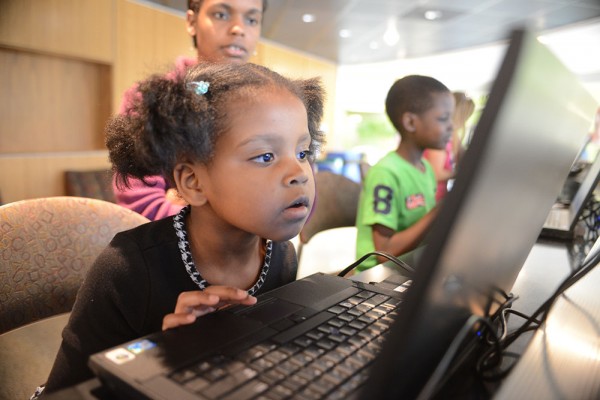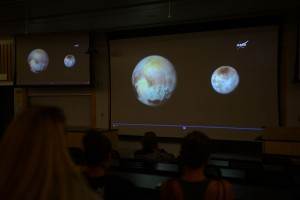Party for Pluto
by Tracy Kalytiak |

Eva Mwamba, 6, and her brother, Hadayah, 9, try out a NASA app, "Eyes on the Solar System," at UAA's Pluto fly-by event Tuesday. Their mother, Dawn Mwamba, stands in the background. (Photo by Tracy Kalytiak/University of Alaska Anchorage)
On Jan. 19, 2006, NASA's New Horizons interplanetary probe launched from a pad at Cape Canaveral Air Force Station in Florida and began its 3-billion-mile journey to Pluto-the tiny moving dot Clyde Tombaugh first discovered in 1930 with the help of a blink comparator.
More than 50 people gathered in a lecture hall Tuesday at UAA's ConocoPhillips Integrated Science Building to watch a NASA movie, The Year of Pluto, celebrate the occasion of New Horizons (carrying Tombaugh's ashes) speeding by Pluto at 30,800 mph within a distance of only 7,750 miles-roughly the same distance from New York to Mumbai, India, according to NASA-and await the arrival of the first up-close images captured of the dwarf planet.
"I definitely think this should be a public thing, and who else is better suited to do a public thing involving space exploration than the planetarium?" said Omega Smith, manager of UAA's Planetarium & Visualization Theater. "It just seems we have to do something like this. If there was no event for this it would be a shame because this is history in the making."
'It's just really cool'
Dawn Mwamba brought her two homeschooled children, Eva, 6, and Hadayah, 9, to the fly-by viewing party, where they tried out NASA's Eyes on the Solar System app.
"One of the homeschool groups on Facebook posted this as a free event, bring your kids, learn all about Pluto, see new pictures of Pluto," Mwamba said. "It was the right timing for us. We just finished this. We did edible solar systems and all these other things, 3-D and everything. And to top it off with a planetarium visit? It's perfect for us. We've never been here so it was right on in so many ways. I know you feel like a geek or something, but it's just really cool."
Reaching the edge of the solar system

Guests at the Pluto fly-by event see photos taken not long before New Horizons reached its closest distance from the planet. (Photo by Tracy Kalytiak/University of Alaska Anchorage)
Guests in the lecture hall watched intently as NASA coverage switched over from commentary about the mission to the Johns Hopkins University Applied Physical Laboratory in Laurel, Md., where they watched flight controllers receive status updates indicating the spacecraft survived the fly-by unscathed.
Lesa Hollen, a UAF neuroscientist who attended the UAA event, cheered after hearing the jubilant flight controllers announce New Horizons was safe.
"I saw this and thought, I really want to be part of this," Hollen said. "This is history. I watched with my dad the lunar landing-one small step for man, one giant step for mankind. This is the same thing. We've done this. To be able to see this happening is just beautiful. There's nothing like being out in the middle of the wilderness when you know you're probably the only one who's ever been there. You can't explain that feeling and that's how I'm feeling right now. Think of the human race. We're out at Pluto now!"
Written by Tracy Kalytiak, UAA Office of University Advancement
 "Party for Pluto" is licensed under a Creative Commons Attribution-NonCommercial 4.0 International License.
"Party for Pluto" is licensed under a Creative Commons Attribution-NonCommercial 4.0 International License.














